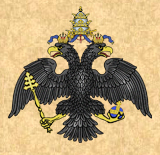|

La Forma del Santo Sacrificio della Messa
del Missale Gallicanum-Romanum
Beginning
through Collects | Epistle through the Sanctus
| Canon through Consecration | Prayers
after the Consecration | Conclusion
THE
CONCLUSION OF THE MASS
The
priest continues the mass after the ablutions with:
THE COMMUNION VERSE
After
reading the Communion Verse for the day, the priest kisses the
altar. Then he turns to the people in the middle of the altar, and
says or sings:
|
V. Dominus vobiscum.
R. Et cum
spiritu tuo.
V. Oremus. |
POSTCOMMUNION
Here
the priest reads or sings the postcommunion prayer(s) for the day.
THE DISMISSAL
He
turns to the people in the center of the altar, first kissing the
altar and saying the Dominus vobiscum,
and says:
|
V. Dominus vobiscum.
R. Et cum
spiritu tuo.
V. Ite,
Missa est.
R. Deo gratias.
If
the Gloria in excelsis has not been
said, there is said instead of the Ite, Missa est:
V.
Benedicamus Domino. R. Deo gratias.
In
Masses for the Dead is said: S. Requiescant in pace. R. Amen.
In
Easter Week is said the following:
V. Ite,
Missa est, alleluia, alleluia. R. Deo gratias, alleluia, alleluia. |
THE BLESSING
Bowing
down before the altar, with hands joined upon it, he says:
|
PLACEAT
tibi, sancta Trinitas, obsequium servitutis meae: et praesta: ut
sacrifi-cium, quod oculis tuae maiestatis indignus obtulit, tibi sit
acceptabile, mihique et omnibus, pro quibus illud obtuli, sit, te
miserante, propitiabile. Per Christum Dominum nostrum. Amen. |
He
kisses the altar, and raising his eyes, extending, raising and
joining his hands, he bows down his head and says:
|
V.
Benedicat vos omnipotens Deus, Pater, et Filius, + et Spiritus Sanctus.
R. Amen. |
In
Masses for the Dead, the Blessing is omitted.
THE
LAST GOSPEL
Then
turning to the Gospel side of the altar, the priest says:
|
V. Dominus vobiscum.
R. Et cum
spiritu tuo. |
He
then traces the Sign of the Cross, first upon the altar, and then
upon his forehead, lips, and breast (the faithful should sign
themselves as well), and says:
|
V. Initium
sancti Evangelii secundum Ioannem.
R. Gloria
tibi, Domine.
IN
principio erat Verbum, et Verbum erat apud Deum, et Deus erat
Verbum. Hoc erat in principio apud Deum. Omnia per ipsum facta sunt:
et sine ipso fac-tum est nihil quod factum est: in ipso vita erat, et
vita erat lux hominem: et lux in tenebris lucet, et tenebrae eam non
comprehenderunt. Fuit homo missus a Deo, cui nomen erat Ioannes. Hic
venit in testimonium, ut testimonium perhiberet de lumine, ut omnes
crederent per illum. Non erat ille lux, sed ut testimonium perhiberet
de lumine. Erat lux vera quae illuminat omnem hominem venientem in
hunc mundum. In mundo erat, et mundus per ipsum factus est et mundus
eum non cognovit. In propria venit, et sui eum non receperunt.
Quotquot autem rece-perunt eum, dedit eis potestatem filios Dei
fieri, his, qui credunt in nomine eius: qui non ex sanguinibus, neque
ex voluntate carnis, neque ex voluntate viri, sed ex Deo nati sunt. (Here
all kneel.) Et Verbum caro factum est, et habitavit in
nobis: et vidimus gloriam eius, gloriam quasi Unigeniti a Patre,
plenum gratiae et veritatis.
R. Deo gratias. |
Variations
to the Holy Mass for certain purposes and occasions are given in the
rubrics and propers of the missal, the Ceremonial, and
Pontifical Instructions.
[Return
to the General Liturgy Page]
[Main
Page]
DISCLAIMER, LEGAL, AND COPYRIGHT NOTICES
|
